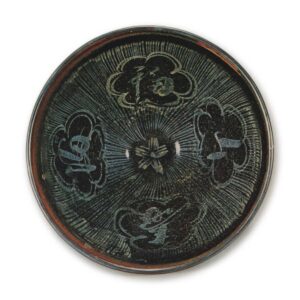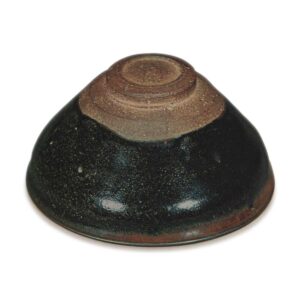

Height: 6.3cm
Diameter: 12.7cm
Height of foot: 4.7cm
Height of rim: 0.7cm
This is a unique tenmoku tea bowl decorated with gold paint to form the characters “Juzan Fukkai”. Such tenmoku tea bowls are also called “Kinsan no Kenzan”, and although only a few examples are known to exist, when you consider them alongside the famous “Kinsan no Teiwan”, etc., they must be considered remarkable relics that contain various issues.
This tea bowl is a Tenmoku tea bowl with a slightly short body compared to the diameter, and a generally gentle appearance. The foot ring is a typical Kenkan design with a shallow inner cutout and a “snake’s eye” foot ring. The part with the tatami mat is slightly higher on the inside and lower on the outside. The scraping around the foot of the rim is strong and precise, showing skilled technique.
The clay is high in iron content, and the red color is very strong. This is quite different from the many Kenzan pieces that are fired to a grayish black. Of course, however, it is not possible to say where this piece was made based on this difference in color alone. It is not entirely true to say that there are no examples of this type of reddish finish among the Kenkan ware.
The glaze is the usual Tenmoku glaze. The whole piece is tinged blue, and the rim is a reddish-brown color both inside and out. The glaze surface is covered with fine irregularities that appear to be the remains of air bubbles, giving the piece a frosted appearance. The only visible rice-shaped patterns are on the rim, and they are barely visible.
On the inside, the four characters “Jusan Fukkai” are written in a cursive style in gold paint, with each character surrounded by a six-petal double flower shape. The characters are written in a fast, strong style, with the vertical strokes thick and the horizontal strokes very thin. In addition to this, thin vertical gold lines are drawn densely from the rim of the mouth to the center of the bowl, and in the center of these lines, a small five-petaled flower is depicted. These lines are also drawn with a practiced speed.
In fact, these gold lines have worn away completely, leaving only traces of silver, so it is not possible to determine whether they are gold or silver just by looking at them. By looking at other examples of gold decoration, we can see that this is the remains of gold decoration. The characters “Jusanzan Fukkai” are a phrase expressing a wish for long life and happiness, like “Fukujukounei” and “Kingyokumandou”. It was from the middle of the Song dynasty that such phrases began to be written on ceramics. Examples of this can be seen on Ding ware and Song red-glazed ware, and it can be said to be one of the characteristic designs of the Southern Song dynasty.
The exact place of origin is still unknown, but it is thought to have been produced in the kilns of the Jian ware type. It is said that there are some differences in terms of style from the so-called Jian ware, but the outlines of Jian ware or Jian kilns themselves are not clear. It would be too early to say that this is from another kiln. In recent years, many kiln sites where Tenmoku tea bowls were fired have been discovered in the area from Fujian to Zhejiang, so it is thought that the production area of this type of bowl will be revealed in the near future.
Considering the soft style of the work and the gold-painted characters, it is thought that it was made during the Southern Song dynasty, around the 13th century. The skillful brushwork suggests that this type of tea bowl was very popular and was being produced in large numbers at the time. It is said that a similar type of tea bowl was also in the collection of the former Royal Family Museum in Korea, so it is not surprising that this type of tea bowl came to Japan.
There is one small repair on the rim, and it has a silver border. The origin is not clear.
(Hasebe Gakuji)



